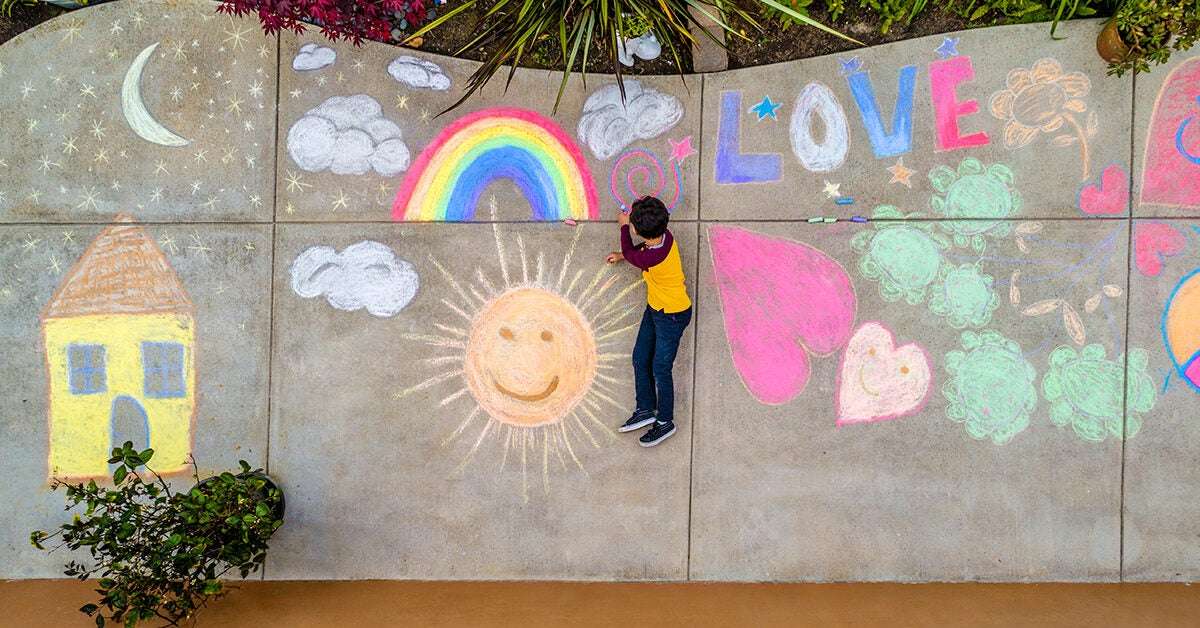Drawing can be an act of self-care — releasing stress, boosting creativity, and promoting mindfulness.

Share on Pinterest
JasonDoiy/Getty Images
Drawing therapy, while not an official name, is essentially drawing as a form of coping and self-care.
Many believe that art (and other forms of creativity) can be healing. Drawing — and other forms of art — can help you release stress and anxiety.
You can draw at home to boost your imagination and creativity, be more mindful and grounded, and relieve anxious thoughts. You can also work with an art therapist to help you manage mental health conditions or trauma.
What is art therapy?
The phrase “art therapy” is often thrown around to describe art as therapy, but there’s also a type of psychotherapy called art therapy.
According to the Art Therapy Credentials Board, Inc. (ATCB), “art therapy uses art media, the creative process, and the resulting artwork as a therapeutic and healing process.”
Anyone can use art as a form of self-care, mindfulness practice, or a way to cope with stress. But in art therapy, you’re typically working with a trained mental health professional to manage symptoms and conditions — often working on issues that are harder to express in words, like trauma.
Essentially, art therapy is art plus psychotherapy.
Benefits of art therapy
A lot of research of varying quality and size has explored the benefits of art and art therapy for mental health.
In a 2010 research review, researchers said that engaging in art had noteworthy positive benefits on health. When doing art, you’re exercising your creativity and imagination, which can help you find your identity and capacity to heal.
According to the ATCB, art therapy can benefit people by helping them:
- explore their feelings
- handle conflicts
- lower anxiety levels
- improve self-esteem and self-awareness
- boost social skills
Experts have also noted that creative art therapy can help with the burden of physical and mental health symptoms, and help you adapt in stressful situations.
Lots of research has shown potential benefits, including:
- A 2018 study found students had more mindfulness and less test anxiety, whether coloring or free drawing.
- A small 2020 study in 60 undergrad students reported that whether they were assigned to draw a design, color a design, or draw to express negative thoughts, students’ anxiety decreased, along with their heart rate.
- A 2019 trial suggests 10 to 12 sessions of art therapy lowered anxiety and improved quality of life in women diagnosed with anxiety disorders.
It’s important to note that most research does study art therapy — art activities under the guidance of a mental health professional. Still, you can find many personal benefits from doing art on your own.
‘Stress drawing’ for stress relief
With the amount of possible things you can do to relieve stress and prioritize self-care, you might wonder: Why choose drawing?
- It’s accessible. You really only need some blank paper and a pencil. Unless you want to get fancy, it’s affordable, and you can do it from anywhere.
- It’s flexible. You can do it alone or with friends, virtually, or in person.
- It’s good for everyone. All ages and identities are welcome.
- You don’t need to be an artist. You might think some skill at drawing is necessary, but that’s not true at all. It’s about the process of drawing, not the art produced.
You may find that drawing helps you express yourself, grounds you, or just distracts you from ruminating thoughts.
How to use art and drawing as therapy
If you’re ready to draw to relieve stress or connect with your creativity, here are some ways to start:
- Prepare. Grab your supplies, whatever that may be. You don’t need to go shopping — you can use any supplies you already have lying around. You can start with a blank piece of paper, plus any pens, pencils, or markers.
- Find your space. Sit down in a space where you can (hopefully) have at least 20 minutes to yourself. Consider sitting down with a glass of water (or bonus: a calming tea!) and sitting comfortably.
- Set your timer and breathe. You can set a timer for 20 to 60 minutes, though you may want to start with 20 and work your way up. If you want to add some mindfulness, once you hit start, begin with a few deep breaths (5 or 10) to ground yourself in the moment.
- Draw. Try to be present while you draw, and remember: There’s no judgment here. You can scribble circles for 20 minutes if you want — it doesn’t need to be museum-worthy.
7 art therapy techniques
The content of what you draw doesn’t really matter if it brings you joy or a moment of release. If you’re still not sure where to get started, here are a few options you can try at home.
1. Scribbling
Some people flourish with a blank canvas, while others may find the possibilities too overwhelming.
You might want to start with a blank piece of paper and see what happens. Try scribbling to your heart’s desire.
Just remember that you don’t have to create something beautiful. Think of it like stream of consciousness, but with shapes, squiggles, and words.
2. Drawing shapes
If scribbling without direction just doesn’t work for you, you could set yourself some shapes. You could draw tons of tiny circles in a large square, lines, or a mix of shapes like creating your own game of Tetris art.
Whatever shape (pun intended) your drawing takes, let it.
3. Drawing prompts
Whether you’re a professional artist or only have a #2 pencil, there are thousands of prompts online to give you some inspiration to draw.
Here are just a few that you can try:
- Drawing designs that resonate with you, like your favorite animal, flower, or memento.
- Drawing at least 10 things that symbolize or express what you’re grateful for. (Bonus: Gratitude can also help boost your mood.)
- Drawing what you see from where you sit — the surface, what you’re drawing with, the window, the decor.
- Drawing to express what you’re feeling right now. Sketching out your negative thoughts or stress about a situation are two good examples. You can even split the time between opposites by drawing negative thoughts for 10 minutes and then logical, positive ones for another 10 minutes.
4. Mandalas
Mandala drawing has a long history, but made its way into psychology with Carl Jung, founder of analytical psychology.
Mandalas are spiritual symbols, often in a circle with geometric shapes. The complexity of the patterns and repetition can promote mindfulness.
In a 2020 study, researchers concluded that mandala drawing could reduce negative emotions and improve spirituality. And according to a small study in 2005, coloring a mandala was shown to reduce anxiety much more than coloring other designs or on a blank page.
You might want to color pre-drawn mandalas, or create your own (and then color them!). This can be a meditative act as well as a creative one.
You can search “mandala drawing prompts” for hundreds of ideas, or start here.
5. Sketching
If you’re done with shapes but are adamant that you can’t freehand, sketching might be a great option to try.
Sketching involves tracing images, often done with a lighter tracing paper placed on top of whatever you want to draw. You can sketch mandalas, magazines, photos — the limit doesn’t exist.
Consider coloring your sketch afterward for continued creativity.
6. Coloring
While some may argue that coloring is not drawing, art is art. Also, a lot of the research on art therapy involves coloring activities, so it can grant us the same stress relief without the need to draw something from scratch.
Coloring options are abundant, with pages you can print online and numerous adult coloring books. You could also color your own drawings, or add color to your drawings with colored markers, ink, or pencils.
7. Mixing mediums
Drawing is one of the most accessible types of art therapies, but you don’t have to stop with a pen or pencil. If you’ve got the supplies lying around or feel like you want to express yourself in more than one way, you can mix art mediums.
Consider:
- adding paints, crayons, colored markers, etc.
- creating a collage with your drawing by gluing pictures or magazine clippings to it
- writing around your drawings (like things you’re grateful for, for instance)
You can also add the benefits of music by playing something soothing or your favorite songs while you draw.
Let’s recap
Including more art in your life can be as easy as grabbing a pencil and paper.
Still, if you feel like you’d benefit from true art therapy, you can find an art therapist via the American Art Therapy Association’s art therapist locator or the Art Therapy Credentials Board (ATCB)’s art therapist search.
If they’re certified through the ATCB, they’ll typically have the credentials ATR (registered art therapist) or ATCS (art therapy credentialed supervisor).
While art therapy is its own field, you can also use self-directed art to express your creative side, reduce stress, and get in touch with your feelings. Most of us understood the power of art instinctively as kids: Virtually all children know the joys of sculpting something with play-dough, painting something with fingers, or drawing with crayons and other materials.
Other than making random doodles in the margins of a page, if you’re like most adults, you probably don’t express yourself with art as you did when you were a kid. You may not think you’re any “good” at creating art, or you may not think it’s worth your time, but art is actually a valuable pastime.
There are many reasons that art is a great stress relief tool, even for those who don’t consider themselves artistically inclined.
Benefits of Art Therapy
Whether you could give Vincent van Gough a run for his money or can barely draw a stick figure, art is a fantastic way to reduce stress. Results of a 2016 study published in the Journal of the American Art Therapy Association found that just 45 minutes of creative activity can reduce your stress, regardless of artistic experience or talent.
Here are some ways that creating art can help alleviate stress:
- Acts as a form of self-care: Sometimes, with all of life’s responsibilities, we forget that we need and deserve downtime and self-care. Taking even a few minutes on a regular basis to devote to a hobby can give you more of what you need in this area. With art, you have the additional benefit of being left with something beautiful (or at least interesting) to show for it.
- Helps you tap into a “state of flow”: Some psychologists describe flow as becoming deeply engrossed in an activity. Similar to meditation, flow can improve performance and lower stress levels.
You may experience flow when you’re practicing an instrument, playing a sport, gardening, writing, painting, or drawing.
- Takes your mind off things: Creating art can take your mind off of whatever is stressing you, at least for a few minutes. It’s difficult to keep ruminating on your problems when you’re focused on creating. If your problems stay with you, you can incorporate them into your creations. Once you’re done, you should have a clearer head with which to tackle your problems again.
Sketchbooks for Stress Relief
Keeping a sketchbook is one of the easiest ways to relieve stress. It can be a form of journaling, and like journaling, it can be cathartic, creative, and stress relieving. You can use a journal for personal art therapy and stress management in the following ways:
- Begin a dream journal. A dream journal can help you identify patterns in your dreams, which point to areas of your life that need extra attention. Try keeping a notebook and pen next to your bed. As soon as you wake up, draw the first images, symbols, or words that come to your mind. Don’t worry if you’re not “good” at drawing. Your dream journal is for your eyes only.
- Draw what you feel. Draw your stress. Drawing literal or abstract representations of what is stressing you out can help you express emotions that may be difficult to put into words.
- Keep a gratitude journal. Many people keep a gratitude journal to catalog what they are grateful for. Personalize your gratitude journal by drawing the faces of those you love, places that bring you peace, or other things that you are grateful for. The process of sketching can be a great stress reliever, and revisiting your creations can also bring you some peace in the future.
- Start coloring. These days, coloring isn’t just for kids. Adult coloring books can be especially relaxing for those who don’t feel artistic, but still want to create beautiful pictures.
A Word From Verywell
If you continue to feel overwhelmed by stress and it starts to interfere with your daily life, talk to your doctor. They might recommend a therapist who can offer support and techniques for managing your stress.




